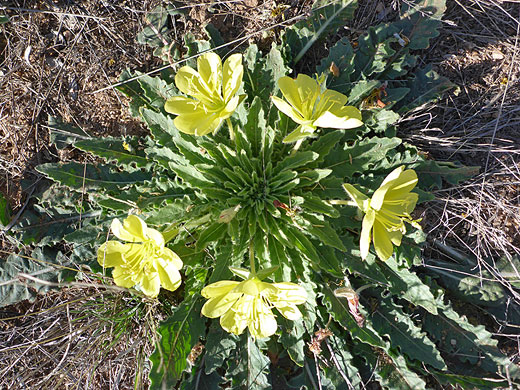Oenothera Primiveris, Yellow-Flower Desert Evening-Primrose
Plants > Wildflowers > Onagraceae > Oenothera Primiveris
Common name:
Yellow-flower desert evening-primrose
Family:
Scientific name:
Oenothera primiveris
Main flower color:
Range:
The Mojave, Sonoran and Chihuahuan Deserts, and adjacent regions
Height:
Up to 12 inches
Habitat:
Sandy flats, hillsides, dunes, washes; up to 4,500 feet
Leaves:
Narrowly lanceolate or oblanceolate, with pinnately lobed edges; up to 11 inches long
Season:
March to May
Petals of oenothera primiveris are light yellow, slightly darker yellow or greenish at the base, and become pale pink to orange as they wither. Petal length varies between 1 and 1.5 inches (ssp bufonis, centered on the Mojave Desert) or between 0.25 and 1 inches (ssp primiveris, the Mojave Desert, and extending east into Texas). Petals are heart-shaped, with a lengthwise groove down the middle extending to a deep notch at the tip, and generally not overlapping when fully open. Sepals are green, up to an inch or more in length, and recurved.
Plants usually have no stems; leaves form as a basal rosette, and the flower stalks also emerge at ground level. The green or gray-green leaves are usually pinnately divided almost to the midvein, into irregularly shaped lobes, often alternating between large and small. Leaves may have a much longer terminal lobe. Leaves and flower stalks have a dense covering of short hairs. Some of the hairs have reddish bases, while those on the sepals may be glandular.
Plants usually have no stems; leaves form as a basal rosette, and the flower stalks also emerge at ground level. The green or gray-green leaves are usually pinnately divided almost to the midvein, into irregularly shaped lobes, often alternating between large and small. Leaves may have a much longer terminal lobe. Leaves and flower stalks have a dense covering of short hairs. Some of the hairs have reddish bases, while those on the sepals may be glandular.
All Contents © Copyright The American Southwest | Comments and Questions | Contribute | Site Map



